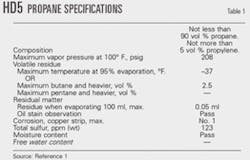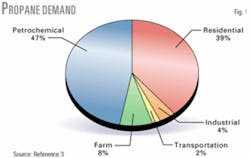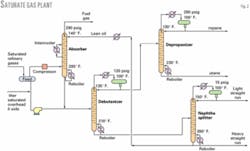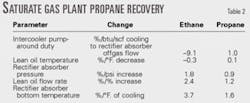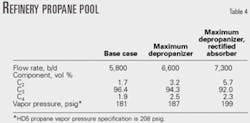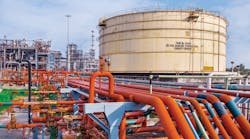A case study determined that a refinery can potentially recover approximately 1,500 b/d or $2.6 million/year of additional propane in the saturate gas plant.
This includes 800 b/d ($1.4 million/year) or 12.3% of incremental propane product by increasing the refinery propane product vapor pressure target and improving the saturate gas plant depropanizer tower control strategy to maximize the vapor pressure and butane content up to their respective specifications.
Adjusting the rectified absorber operation allowed the refinery to recover another 700 b/d of incremental propane product.
Propane production
As petroleum refining margins have tightened, refiners have experienced increasing pressure to maximize product recovery and lower costs. The prices of refined fuels have lagged inflation for decades thus the petroleum refineries have had to cut costs to survive.
Refiners focused on maximizing motor fuels production can lose focus on recovery of lower yielding, yet highly profitable products. One of these products is heavy-duty 5 (HD5) propane for engine fuel. The 5 stands for 5% maximum propylene.
LPG-grade propane produced in a refinery is typically a mixture of two propane streams: one from the saturate gas plant and the other from the alkylation unit.
Due to limitations on the ethane content in alkylation unit feeds, the alkylation unit propane will have a significantly lower vapor pressure (giveaway) than the HD5 propane specifications (Table 1). The saturate gas plant's propane product is therefore where the refinery can control the vapor pressure of its HD5 propane sales pool by adjusting the amount of ethane.
Increasing the vapor pressure of the saturate gas plant propane up to the pool limits can greatly improve a refinery's propane recovery and increase refinery profitability.
Value of recovery
Propane is used for water and space heating, cooking, drying clothes, and fueling vehicles. It is a major petrochemical feedstock in the manufacture of alcohols, fibers, plastics, cosmetics, and others products (Fig. 1).2
Greater demand for propane increases its value for refiners selling it as LPG vs. using it internally as fuel gas. This upgrade value averages approximately $5/bbl, one of the highest value separations a fuels refinery earns.
Many refiners can improve the propane recovery in the saturate gas plant for little or no investment. Even though propane production is only a small fraction of a petroleum refinery's product slate, the significant upgrade value can create a noticeable improvement in the bottom-line.
Process description
Fig. 2 shows flow sequence and arrangement of a typical saturate gas plant.
The saturate gas plant separates refinery gases into components, such as pentanes for gasoline blending, butanes for alkylation and gasoline blending, LPG propane, and fuel gas.4
Feeds to the saturate gas plant consist of streams from many refinery units including the hydrocracker, naphtha hydrotreater, distillate hydrotreater, catalytic reformer, and crude unit. Off-specification propane and butanes can also feed the saturate gas plant for reprocessing.
Principal equipment in the saturate gas plant consists of a feed gas compressor, rectified absorber, depropanizer, debutanizer, and naphtha splitter. Gases from various refinery units feed the feed knockout drum. These gases flow from the feed drum to a compressor and are cooled before feeding the rectified absorber.
The rectified absorber separates ethane and lighter fractions from heavier fractions using lean oil absorption and fractionation. Absorber overhead gas flows to the refinery fuel gas system or is used as a petrochemical feed.
Absorption in the rectified absorber is adjusted with the tower's steam reboiler on temperature control. Other parameters that affect absorption are the rectified absorber operating pressure, lean oil temperature, intercooler duty, and lean oil rate.
Absorbed gases, along with the lean oil and refinery light liquids, feed the debutanizer and are separated. Adjustments in the debutanizer's reboiler allow it to maintain a specified butane content in the naphtha.
The debutanizer overhead offgas is recycled to the saturate gas plant compressor on pressure control. The debutanizer liquid overhead stream is a mixture of propane and butane.
The propane-butane stream flows to the depropanizer, which separates the butane from the propane. The column's reflux rate is adjusted to meet a specified butane content in the propane. The depropanizer overhead liquid product flows to propane product storage where it blends with alkylation unit propane to form the refinery LPG propane sales.
The naphtha (debutanizer bottoms) feeds the naphtha splitter where a portion of the bottoms product is recycled as lean oil back to the rectified absorber. The remainder feeds the naphtha hydrotreater as heavy straight-run naphtha. The overhead product is condensed and pumped to product tankage rundown as light straight-run naphtha.
The butane stream, which is depropanizer column bottoms, flows to the alkylation unit where the isobutane is fractionated out to feed the alkylation reaction and normal butane is routed to gasoline blending. Saturate gas plant depropanizer overhead vapors flow to fuel gas header on pressure control.
Improved propane production: case study
A case study determined strategies to maximize refinery propane recovery. Approximately 800 b/d or 12.3% of incremental propane product can be recovered by increasing the refinery propane product vapor pressure target and improving the saturate gas plant depropanizer tower control strategy to maximize the vapor pressure and butane content to their respective specifications. The additional yield is worth $1.4 million/year.
Further improvements in propane recovery in the gas plant would require improvements in the refinery propane control strategy, including integrating the rectified absorber operation with the alkylation unit propane product quality and quantity.
A test run on the saturate gas plant determined if there were further opportunities to improve propane recovery. Historical data on the rectified absorber offgas indicated a relatively high 10.1 mole % loss of propane to fuel gas. The test run confirmed a greater concentration of 11.7 mole % unrecovered propane.
Even with the previous improvements in depropanizer propane recovery and the increased vapor pressure target, a significant portion of the propane and ethane was lost in the rectified absorber offgas stream. Depending on the variable, the incremental barrel from the rectified absorber may be more or less selective than the HD5 propane specification (Table 2).
The saturate gas plant is where adjustments can be made to the propane sales pool to minimize giveaway; therefore, its propane stream does not need to meet the HD5 specification on its own.
Based on modeling using the historical 10.1% average propane concentration in the rectified absorber offgas, an additional potential increase of 700 b/d ($1.2 million/year) of propane product can be recovered via these operational targets:5
- Maximize rectified absorber tower operating pressure.
- Minimize lean oil temperature.
- Maximize intercooler pumparound heat removal.
- Minimize rectified absorber tower reboiler duty.
- Maximize lean oil rate.
As a result of these changes and the improvements in the refinery propane system, the total potential increase in propane recovery in the saturate gas plant is about 1,500 b/d, $2.6 million/year, or 26% of base production.
Absorber tower pressure
Increasing the rectifier absorber tower pressure decreases the offgas propane content composition significantly. The incremental absorbed barrels of ethane-propane can be 70-80% propane; however, most refiners can handle this dilution because saturate gas plant propane is mixed with low-vapor-pressure propane from the alkylation unit.
This will help to increase the vapor pressure of the propane sales pool and reduce giveaway up to the specification of 208 psig. If the equipment is protected with a conventional relief valve, the rectified absorber pressure can usually run at 90% of the relief setting.
Lean oil temperature
The lean oil temperature should be decreased to the design operating temperature or lower if possible.
Overall, there will probably be no noticeable change in the flow rate of the ethane-propane combined absorbed barrels; however, the efficiency of the ethane-propane separation increases and the vapor pressure of the saturate gas plant propane decreases. This increases the purity, i.e., the quantity of propane absorbed relative to ethane.
Most lean oil coolers are designed to maintain a temperature of approximately 100° F. lean oil.
Intercooler pumparound heat removal
The intercooler pumparound rate should be increased to the design operating flow or greater, if possible, to maximize heat removal (Table 3).
This change slightly decreases the overall absorbed barrels of ethane-propane, but substantially improves the separation efficiency between ethane and propane, which increases the quantity of propane absorbed relative to ethane.
Refiners will often allow this pumparound to fall into disrepair when there are budget constraints without realizing the value it offers. Of all the variables mentioned herein, increasing intercooler pumparound rate and increasing heat removal is the most selective in increasing propane recovery without ethane. This ultimately allows the saturate gas plant to absorb more propane out of the fuel gas system.
Rectified absorber tower reboiler duty
A lower absorber tower bottoms temperature controls the vapor pressure of the entire refinery propane sales pool. This change allows more incremental ethane than propane to be absorbed into the liquid; therefore, its vapor pressure is much higher than the 208-psig HD5 propane specification.
Because this variable is the least selective in absorbing propane and is fairly easy to control, it provides operations a leveraged way to adjust the vapor pressure of the refinery sales pool.
Lean oil flow rate
Maximizing the lean oil flow rate can have the greatest effect on the quantity of propane recovered.
Absorption is a function of molecular interaction, not of volumetric flows. The optimum lean oil choice is therefore approximately 3 carbon atoms heavier than the lightest component absorbed.6
If one chooses to use diesel lean oil instead of naphtha lean oil at the same volumes, the amount of absorption is about 50% lower. The diesel stream, however, is slightly more selective in recovering propane instead of ethane, with approximate values of 10%/90% vs. 13%/87% using diesel lean oil vs. naphtha lean oil for ethane/propane absorption, respectively.
Control improvements
When limited by depropanizer condenser duty, the refiner should make a lower-purity propane product with more butane if possible. This will allow the refiner to recover more propane than when making a high-purity propane product.
Reflux and reboil should be minimized to allow the maximum allowable butane in the HD5 propane specification, 2.5%. This control optimizes the available condenser duty to maximize overhead liquid (propane) production.
The refiner should control the depropanizer overhead composition using the tower temperature about 5 trays below the depropanizer's top, in the vapor space. Usually refiners either control with the overhead temperature or sometimes the liquid tray temperature. These temperatures are much less sensitive to the overhead butane content than the vapor space about 5 trays below the tower's top.
The rectified absorber reboiler should be controlled to maximize the ethane content in HD5 propane. The vapor pressure specification of propane is in psig, not in psia. The bottom tray and reboiler return temperatures are less sensitive to the absorbed ethane content than the temperature a few trays above the column's bottom.
Propane vapor pressure is best controlled at the rectified absorber. Using the depropanizer overhead vent for vapor pressure control is inefficient because it is a poor separation—essentially a flash. The rectified absorber is much more selective in controlling vapor pressure.
The HD5 propane specification must be met at the refinery fence line, after gas plant propane is blended with the alkylation unit's low vapor pressure propane. To maximize propane production, the saturate gas plant propane should run over the 208-psig vapor pressure specification as long as the alkylation unit is producing low vapor pressure propane. An analyzer on the combined propane production will provide operations a direct feedback on the operational changes made to maximize propane recovery at the saturate gas plant.
Lean oil should be stabilized to be most effective. If it is unstabilized, one should review the system to see if the lean oil is possibly increasing offgas or removing it. If there are two streams feeding the rectified absorber, the stabilized lean oil should feed the tower's top and the unstabilized liquid should feed below this point.
Operational improvements
The rectified absorber was modeled in Simsci's Provision software to determine which variables influence the absorbed propane recovery quality and quantity.
Even after adjusting the saturate gas plant depropanizer to almost total condensing, the propane product still had a significant vapor pressure giveaway. To reduce this vapor pressure giveaway, the refiner should adjust the rectified absorber's operation to drop more ethane and propane to meet the HD5 propane product specification.
Six case studies were completed to review the effect on propane recovery relative to Base Case data:
- Case 1. Maximize rectified absorber tower operating pressure. The rectified absorber operating pressure was increased to 302 psig from 262 psig. This decreased the offgas composition to 9.3 vol % from 11.7 vol %. The incremental absorbed volume of ethane-propane was 230 b/d and had a 76% propane purity.
The increase in operating pressure is well within the design maximum allowable working pressure; the rectified absorber design operating pressure was 295 psig and the relief valve setting was 345 psig.
- Case 2. Minimize lean oil temperature. The lean oil temperature to the rectified absorber was lowered to the design operating temperature of 100° F. from 131° F. The flow of ethane-propane absorbed barrels increased slightly, but the efficiency of the ethane-propane separation increased with an incremental ethane purity decrease of 9%. The lean oil cooler could have been fouled.
- Case 3. Maximize intercooler pumparound heat removal. The intercooler pumparound rate was increased to the design operating flow of 13,500 b/d from 6,500 b/d. This increased the pumparound duty to 3.3 MMbtu/hr—well within the design duty of 4.2 MMbtu/hr—from 1.7 MMbtu/hr. This change slightly decreased the overall absorbed barrels of ethane-propane, but improved the separation efficiency between them with an incremental ethane purity decrease of 24%.
This preferential absorption of propane vs. ethane allows for significantly more volume of absorbed propane compared to using the other operating variables to increase the vapor pressure.
- Case 4. Minimize rectified absorber tower reboiler duty. The rectified absorber bottoms temperature was reduced to 292° F. from 322° F. This change decreased the rectified absorber offgas propane composition to 8.7% from 11.7%. The incremental absorbed barrels of ethane-propane were 310 b/d with a 73% propane purity.
This case increased propane recovery but decreased overall ethane-propane separation efficiency.
- Case 5. Maximize the lean oil flow rate. The lean oil rate was increased to 10,500 b/d from 6,500 b/d. This change absorbed the most propane and decreased the overhead propane concentration to 6.7% from 11.7%.
The incremental absorbed volume of ethane-propane was 560 b/d with a propane purity of 75%. The 10,500 b/d lean oil rate is within the pump design capacity.
- Case 6. Combination of Cases 1, 2, 3, and 5. This combination decreased absorber offgas propane composition to 3.8% from 11.7%. The incremental absorbed volume of ethane-propane was 810 b/d with a propane purity of 80%. Mixing this incremental volume into the refinery propane pool increases the sales pool vapor pressure to 199 psig.
Overall, the combination of these four operating changes maximized propane recovery while satisfying the target vapor pressure. When Case 4 was added to the other four case studies, propane recovery decreased due to the higher percentage of ethane absorbed with the propane.
Combined optimization strategy
Because of this study, the propane recovery improved significantly when the refiner implemented the operational and control improvements. The entire refinery propane sales pool vapor pressure was adjusted by changing the rectified absorber bottoms temperature. The vapor pressure giveaway was reduced to the vapor pressure specification of 208 psig.
Approximately 800 b/d of incremental propane product was recovered by changing the propane product vapor pressure target and by improving the saturate gas plant depropanizer tower control strategy. Adjusting the rectified absorber operation and considering the impact to the overall HD5 propane sales pool allowed the refinery to recover another 700 b/d of incremental propane product (Table 4).
The total potential increase in propane recovery in the saturate gas plant was about 1,500 b/d, 26% above base, with a value of $2.6 million/year.
Table 4 shows the refinery HD5 propane sales pool changes.
Table 5 shows the saturate gas plant propane compositions before and after implementing operational improvements to the rectified absorber and depropanizer.
References
1. GPSA Data Book, 10th Ed., Tulsa: Gas Processors and Suppliers Association, pp. 2-3.
2. http://www.eia.doe.gov/emeu /plugs/propane.htm.
3. Florida Propane Gas Safety, Education and Research Council, http:// www.propanefl.com/propanedemand .htm.
4. SET Laboratories Inc., http:// www.setlaboratories.com/gas.htm.
5. 1999 NPRA Q&A Session on Refining and Petrochemical Technology, Washington DC: National Petrochemical & Refiners Association, pp. 85-86.
6. Rules of Thumb for Chemical Engineers, Branan, R., ed., Houston: Gulf Publishing Co., p. 76.
The author
Stephen M. Haik is a hydrocarbon plan implementer for Motiva Enterprises LLC in its Norco, La., refinery. Previous to his current position, he worked as a project engineer and process engineer. Haik previously worked for KBC Advanced Technologies Inc. and Mobil Oil Corp. He holds a BS (1991) in chemical engineering and an MBA (2003), both from Tulane University. Haik is a registered professional engineer in Louisiana.

